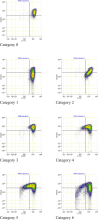Visualization of the inflammatory response to injury by neutrophil phenotype categories : Neutrophil phenotypes after trauma
- PMID: 36348032
- PMCID: PMC10175373
- DOI: 10.1007/s00068-022-02134-3
Visualization of the inflammatory response to injury by neutrophil phenotype categories : Neutrophil phenotypes after trauma
Abstract
Purpose: The risk of infectious complications after trauma is determined by the amount of injury-related tissue damage and the resulting inflammatory response. Recently, it became possible to measure the neutrophil phenotype in a point-of-care setting. The primary goal of this study was to investigate if immunophenotype categories based on visual recognition of neutrophil subsets are applicable to interpret the inflammatory response to trauma. The secondary goal was to correlate these immunophenotype categories with patient characteristics, injury severity and risk of complications.
Methods: A cohort study was conducted with patients presented at a level 1 trauma center with injuries of any severity, who routinely underwent neutrophil phenotyping. Data generated by automated point-of-care flow cytometry were prospectively gathered. Neutrophil phenotypes categories were defined by visual assessment of two-dimensional CD16/CD62L dot plots. All patients were categorized in one of the immunophenotype categories. Thereafter, the categories were validated by multidimensional analysis of neutrophil populations, using FlowSOM. All clinical parameters and endpoints were extracted from the trauma registry.
Results: The study population consisted of 380 patients. Seven distinct immunophenotype Categories (0-6) were defined, that consisted of different neutrophil populations as validated by FlowSOM. Injury severity scores and risk of infectious complications increased with ascending immunophenotype Categories 3-6. Injury severity was similarly low in Categories 0-2.
Conclusion: The distribution of neutrophil subsets that were described in phenotype categories is easily recognizable for clinicians at the bedside. Even more, multidimensional analysis demonstrated these categories to be distinct subsets of neutrophils. Identification of trauma patients at risk for infectious complications by monitoring the immunophenotype category is a further improvement of personalized and point-of-care decision-making in trauma care.
Keywords: Infection; Inflammation; Injury; Neutrophil; Trauma.
© 2022. The Author(s).
Conflict of interest statement
All authors declare that they have no potential conflict of interest. There are no competing interests (financial or non-financial).
Figures
Similar articles
-
Identification of neutrophil phenotype categories in geriatric hip fracture patients aids in personalized medicine.OTA Int. 2023 Dec 22;6(5 Suppl):e291. doi: 10.1097/OI9.0000000000000291. eCollection 2023 Dec. OTA Int. 2023. PMID: 38152436 Free PMC article.
-
Point-of-Care Analysis of Neutrophil Phenotypes: A First Step Toward Immuno-Based Precision Medicine in the Trauma ICU.Crit Care Explor. 2020 Jul 17;2(7):e0158. doi: 10.1097/CCE.0000000000000158. eCollection 2020 Jul. Crit Care Explor. 2020. PMID: 32766555 Free PMC article.
-
Instant intra-operative neutropenia despite the emergence of banded (CD16dim/CD62Lbright) neutrophils in peripheral blood - An observational study during extensive trauma-surgery in pigs.Injury. 2021 Mar;52(3):426-433. doi: 10.1016/j.injury.2020.11.018. Epub 2020 Nov 6. Injury. 2021. PMID: 33208273
-
Longitudinal assessment of the inflammatory response: The next step in personalized medicine after severe trauma.Front Med (Lausanne). 2022 Sep 20;9:983259. doi: 10.3389/fmed.2022.983259. eCollection 2022. Front Med (Lausanne). 2022. PMID: 36203773 Free PMC article. Review.
-
Neutrophil heterogeneity and its role in infectious complications after severe trauma.World J Emerg Surg. 2019 May 29;14:24. doi: 10.1186/s13017-019-0244-3. eCollection 2019. World J Emerg Surg. 2019. PMID: 31164913 Free PMC article. Review.
Cited by
-
Neutrophil cell surface receptor dynamics following trauma: a systematic review.Eur J Trauma Emerg Surg. 2025 Aug 11;51(1):270. doi: 10.1007/s00068-025-02937-0. Eur J Trauma Emerg Surg. 2025. PMID: 40788542 Free PMC article. Review.
-
Exploring the role of systemic inflammation in guiding clinical decision making for geriatric patients with a hip fracture.Eur J Trauma Emerg Surg. 2025 May 6;51(1):192. doi: 10.1007/s00068-025-02875-x. Eur J Trauma Emerg Surg. 2025. PMID: 40325151 Free PMC article.
-
Identification of neutrophil phenotype categories in geriatric hip fracture patients aids in personalized medicine.OTA Int. 2023 Dec 22;6(5 Suppl):e291. doi: 10.1097/OI9.0000000000000291. eCollection 2023 Dec. OTA Int. 2023. PMID: 38152436 Free PMC article.
-
Change in resuscitation influenced development and severity of inflammatory complications in severely injured.Eur J Trauma Emerg Surg. 2025 Jun 23;51(1):232. doi: 10.1007/s00068-025-02905-8. Eur J Trauma Emerg Surg. 2025. PMID: 40549182 Free PMC article.
-
Limited impact of traumatic brain injury on the post-traumatic inflammatory cellular response.Eur J Trauma Emerg Surg. 2024 Dec;50(6):3049-3058. doi: 10.1007/s00068-024-02574-z. Epub 2024 Jul 9. Eur J Trauma Emerg Surg. 2024. PMID: 38980396 Free PMC article.
References
-
- Wafaisade A, Lefering R, Bouillon B, Sakka SG, Thamm OC, Paffrath T, et al. Epidemiology and risk factors of sepsis after multiple trauma: an analysis of 29,829 patients from the Trauma Registry of the German Society for Trauma Surgery. Crit Care Med. 2011;39:621–628. doi: 10.1097/CCM.0b013e318206d3df. - DOI - PubMed
-
- Haagsma JA, Graetz N, Bolliger I, Naghavi M, Higashi H, Mullany EC, et al. The global burden of injury: Incidence, mortality, disability-adjusted life years and time trends from the global burden of disease study 2013. Inj Prev. 2016;22(1):3–18. doi: 10.1136/injuryprev-2015-041616. - DOI - PMC - PubMed
MeSH terms
LinkOut - more resources
Full Text Sources



